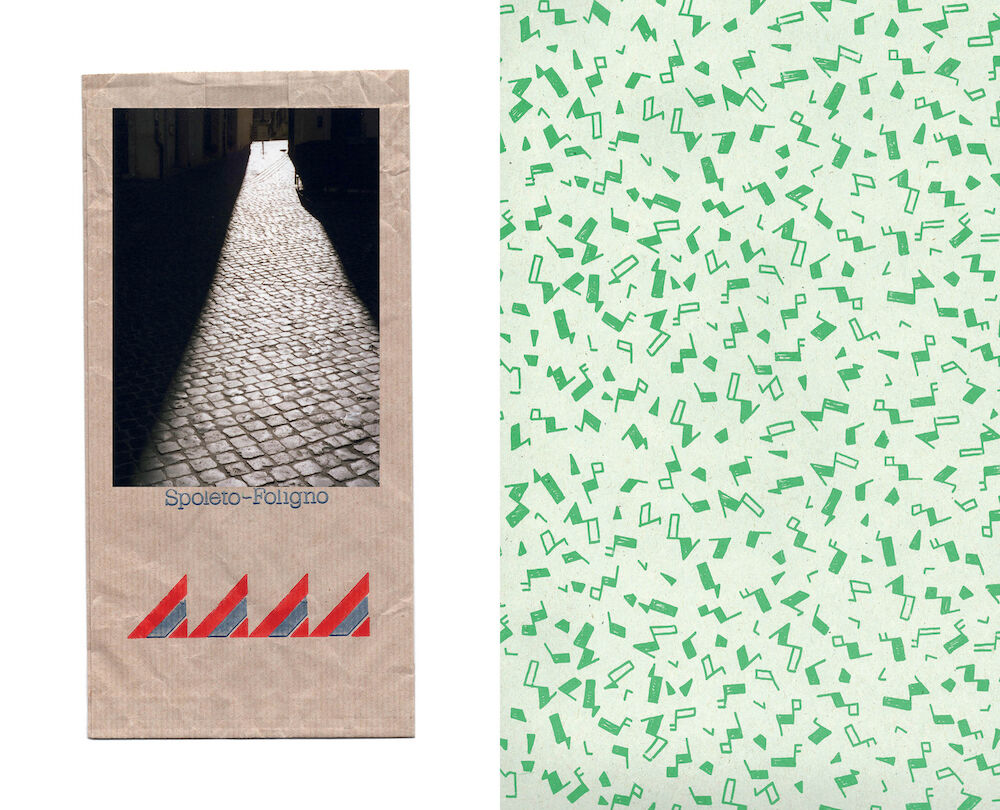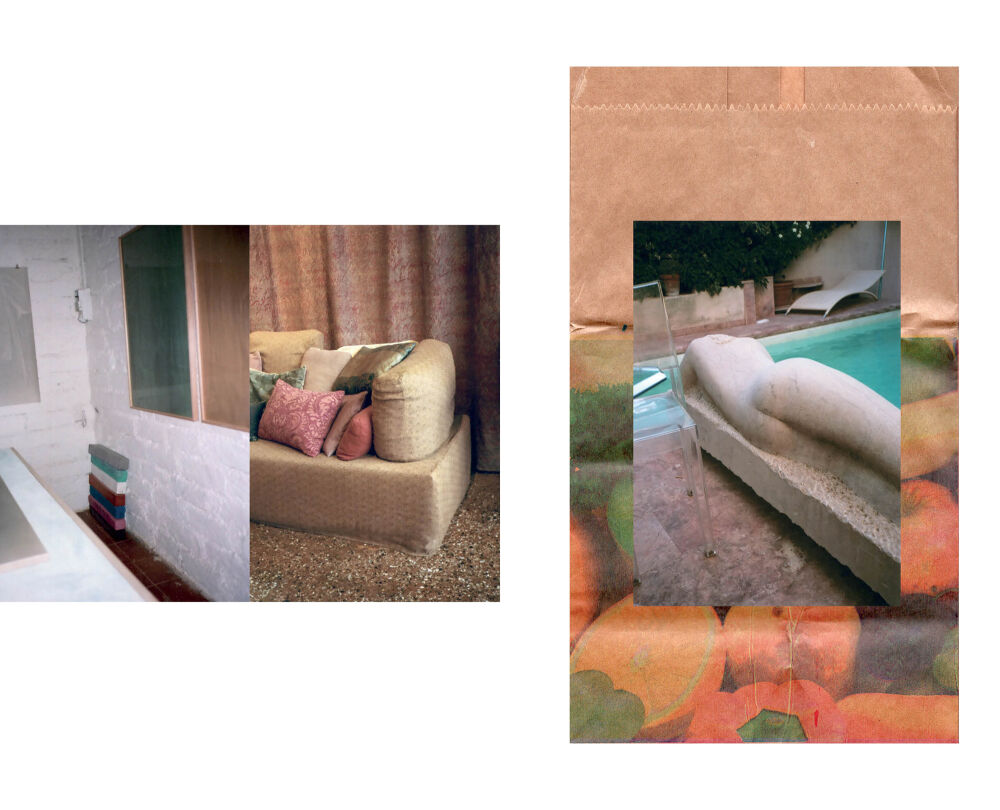
From Ciao!, in issue no. 242 (Winter 2022). Courtesy of Mary Manning and Canada Gallery.
Mary Manning’s portfolio for the Winter issue of the Review documents a summer spent in Italy. Their collages are perfect expressions of the special kind of vision you have on vacation, when everything—pizza receipts, sidewalk seating, wildflowers—looks new and exciting, strangely saturated. Manning’s work not only captures but literally incorporates their world in order to rearrange it, ever so gently, at an angle: in Ciao!, there’s a cantaloupe wrapper and a bag from a pharmacy, plus photographs of their friends, of a Nicola De Maria fresco, and of a performance of a Trisha Brown dance. Manning was born in Alton, Illinois in 1972 and lives in New York City. In 2006, they began sharing digital photographs of their everyday life on their blog alongside scans of objects and links to the work of musicians, filmmakers, writers, and other artists they admire. Today, their work appears in print and on gallery walls across North America. The book Manning was preparing last summer, Grace Is Like New Music, a collection of images spanning ten years of their work, will be published by Canada Gallery in February. We talked about looking at images nonlinearly, as well as Italian graphic design, postmodern choreography, and bags (paper and plastic).
INTERVIEWER
Do you take photos differently when you’re on vacation?
MANNING
Yes. For better, for worse, you’re changed when you’re on vacation. There can be a long stretch of time in New York City where I’m just not in the flow of being inspired. When you travel, you’re plucked out of the sky and plopped down on the other side of a huge body of water. You get off a plane and it’s a shock to be in a different light.
INTERVIEWER
Where were you when you took the photos for this portfolio?
MANNING
The photos and the ephemera are all from a six-week period I spent at the Mahler & LeWitt Studios residency in a smallish town called Spoleto in central Italy, about an hour north of Rome. I’m calling it Rome’s upstate. The sculptor Anna Mahler and the painter Sol LeWitt both lived and worked there. They never met, but their studios were in such insane proximity. The residencies take place primarily in Sol’s studio. The energy of that space was infectious. I was working there while sequencing the photos for my book in these gridded arrangements. When I was done, I laughed, because I didn’t even really think about the connection until then. I thought, Oh my God, this is a vibe. It was like osmosis.
INTERVIEWER
Oh, yes, because of his squares! I was actually going to ask about rectangles, and the geometry of your work. Do you ever make nonrectangular collages?
MANNING
It’s funny. Even with ephemera, it’s rare that I choose to use something oddly shaped. I’ve made several pieces that include butterfly or moth wings. But even then, they always sit in a rectangular shape: a frame or page, for example.
INTERVIEWER
What happens later, in your studio?
MANNING
Much of what I do there is envision arrangements and relationships between images. I have a long table and a magnetic wall. The table is where most of those arrangements happen, and the wall is where larger groupings come together. This process tends to be playful. I might start out by setting a bunch of pictures on a napkin and saying, Well, that looks really cool. And then just sitting with that arrangement, and maybe knowing that I won’t use it but that I’ve come one step closer. Later, maybe the images that were in harmony with one another will stay and the napkin will go. Sometimes using ephemera feels like a trick, a fun kind of device. But I want to find the gentlest version of the arrangement. It’s like letting something seep through a mesh sieve and seeing what stays.
People like to ask me, Why did you put these two things together? But it’s the images and their relationships with one another that tell me where they want to go. I like to allow space for the viewer to come up with their own understanding of the dynamics present in the work, whether it’s the relationships between the ephemera and the photos, or the size of the photos, or the juxtaposition of a blank page with a full page. It’s a funny time in the world of images, especially because of social media, which directs our visual attention in specific, programmed ways. It’s exciting not be told how to look for once. In the three-hundred-page book of my work I just made, there are no titles on any work, no dates, no page numbers. I wanted a reader to open the book and feel like, You can go this way; you can go that way. Choose your own adventure.
INTERVIEWER
When you look at the images in your Paris Review portfolio now, are the memories of those moments still attached for you? Or have they become flattened, so to speak, into the artwork?
MANNING
No. The photos are so personal. Despite what I said about creating mystery and choosing your own adventure, I’m very happy to tell the story behind every photograph.
INTERVIEWER
Tell me some of those.

From Ciao!, in issue no. 242 (Winter 2022). Courtesy of Mary Manning and Canada Gallery.
MANNING
The photo in this one is in the little piazza around the corner from the studio, at the bottom of this very tiny slope. I took it through this narrow walkway in the morning, when it was incredibly bright. And then the brown bag underneath is from a pharmacy or a hardware store. I think it was a hardware store.
INTERVIEWER
They have so many different types of bags in Italy!
MANNING
Yes, and the graphics and the fonts in Italy— they blew my mind. On the right, for example, is a folder from an office supplies store, which was the only art supplies store in town, a completely jam-packed, very sweet mom-and-pop place. The folders there had to be thirty or forty years old, maybe more.

From Ciao!, in issue no. 242 (Winter 2022). Courtesy of Mary Manning and Canada Gallery.
INTERVIEWER
The depth perception in all of these spreads is so disorienting. Maybe because there are so many different textures, so many different degrees of three-dimensionality. How do you think about perspective in your work?
MANNING
I think there’s something fun about the kind of zoom or bend you see in these images. When I first started taking photos, I used a digital camera. I was hyperconcentrated on zoom. When I switched to analog, the types of pictures I was taking didn’t change, but the zoom changed—you can’t zoom as easily with an analog camera. I realized, “I have a roll of film, I can only take this shot. I can’t crop it. I’m not interested in doing work on it after the fact. I get what I get.” I had already trained my eye from seven years of taking forty thousand digital images a day. Now, I literally have to use my body to figure out what I want to see in the frame.
I’m not necessarily conscious of trying to knock off the stability of an image, but I do like upsetting the very pristine. Maybe there’s an angle in my eye somewhere. I’m lopsided.
INTERVIEWER
What were you doing in Spoleto when you weren’t taking pictures?
MANNING
I read a lot: the book you see in the portfolio, Goethe’s Italian Journey, which also references Spoleto; a book by Imogen Binnie, Nevada; and a book of Wolfgang Tillmans’s interviews, which are so inspiring. I feel a total affinity for him as a human and for what he’s doing.
INTERVIEWER
Are there particular writers who capture in language something similar to what you do in images?
MANNING
Mostly poets. In poetry, the words are strung together in a way that’s similarly nonlinear but has a logic. For the poet, it might just be that a certain word has to go next. And it’s up to the reader or the listener to figure out what’s happening in that language or that cadence. I love Mary Ruefle, Alice Notley, and Tim Dlugos, for example. But film and dance have a closer relationship to my work. Especially modern dance and postmodern choreography—they have the same kind of feeling I’m trying to convey or experience.
INTERVIEWER
Is that because, in modern dance, the movement is nonlinear? Before, you talked about wanting your audience to navigate your book in a variety of directions.
MANNING
Completely. That summer, while I was at the residency, I saw these amazing films by Michael Blackwood, a filmmaker who spent a lot of time with artists, choreographers, and composers, making portraits of them. In one that I saw—Making Dances: Seven Post-Modern Choreographers—the choreographer Kenneth King described his work like this: “It’s about rhythm … It’s about signals. When you work with open form, you’re proliferating or boiling up more pulses and impulses … remembering that the grid is like an abacus, so that the movements are like pieces of currency or coinage opening up space.” I wrote that down in my notebook. I thought, Maybe that’s it. Maybe that’s what I do.
INTERVIEWER
Your work also reminds me a lot of Tumblr or Pinterest.
MANNING
It is a lot like Tumblr in that each collection is a kind of visual catalog, much like the ephemera that you come across in image blogs. The Tumblr era of image sharing and collecting was a huge part of what propelled me to share my work more widely. I started a photo blog in the early aughts, and then I was part of a huge, robust group of other image freaks. There were these image aggregators that would aggregate fifty to two hundred new posts every day from other blogs that you followed. I was constantly pulling images from these archival Tumblrs, blogs that would reshare found images, and then using them on my own blog. I had a website that is still online called Unchanging Window. I would use it like Instagram: I’d post a series of images every day. And there was a page called Other, and that was my version of Tumblr, or like an homage to other Tumblrs. I got a scanner and would scan cool plastic bags that I got. That’s when I realized, Oh, yeah. You’re permitted to take these things from 3D-analog-real-thing world and bring them into 2D-internet world.
INTERVIEWER
Do you have a favorite kind of souvenir?
MANNING
Bags. One hundred percent. Paper bags. I love plastic bags, too, but the paper ones really do it for me.
Olivia Kan-Sperling is an assistant editor at The Paris Review.
from The Paris Review https://ift.tt/84eckqE
Comments
Post a Comment